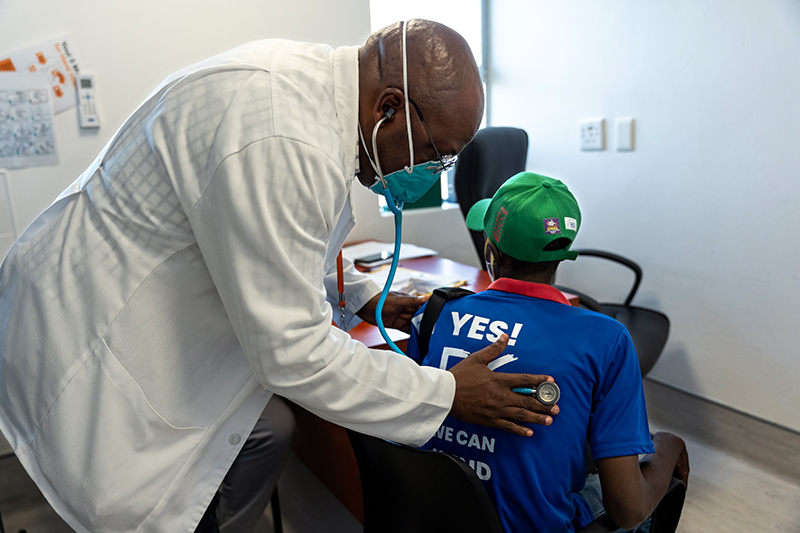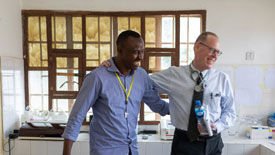Eliminating Tuberculosis with the Search, Treat, and Prevent Approach for All
Each step is an important part of ending unnecessary deaths from TB
Posted on Mar 25, 2025

At Partners In Health (PIH), we aspire to eliminate tuberculosis (TB)—for everyone, everywhere. With the right approach and care, we know that achieving this ambitious goal is possible. After all, we’ve already seen tremendous progress from our work over more than three decades—beginning with reimagining TB care and treatment in 1989 to the approval of safer, shorter medication routines in 2024.
But, there’s still more work to do in eliminating the world’s deadliest infectious disease.
Below, learn more about how PIH is reenvisioning the search, treat, and prevent approach and how it’s part of our comprehensive plan to alleviate suffering from TB for all.
What is the search, treat, and prevent approach?
The search, treat, and prevent approach is a three-part method to address TB. While much of the framework was laid in the 1990s, the approach was formalized decades later. It’s used by governments, public health organizations, and others in countries around the world.
Why is PIH reenvisioning the approach?
In practice, the current search, treat, and prevent approach tends to focus more heavily on one pillar—typically “treat”—and often cannot reach the full population. At PIH, we are reenvisioning the approach to simultaneously carry out each pillar for a wider group of people—what we refer to as “universal access search, treat, and prevent.” Rooted in historic examples of successes in driving down rates of TB, we believe universal access search, treat, and prevent can more successfully move the world towards eliminating TB.
What is PIH's universal access search, treat, and prevent approach?
The universal access search, treat, and prevent approach involves:
Search: This means actively searching for and properly identifying TB in communities, many of which are remote and hard to reach. In Lesotho and other countries, PIH TB screeners do meticulous contact tracing to identify individuals who have been in close contact with TB. At PIH, we welcome the use of innovative tools to search and test for TB, such as artificial intelligence-enabled X-rays to reach more people with TB screenings; and work tirelessly to expand access to where the tools are most needed.
Treat: This involves medication, food, counseling, and other resources that are necessary to make people with TB well again. Treatment includes a comprehensive care team—including nurses, doctors, and treatment supporters—who have the skills and knowledge to treat many forms of tuberculosis, including multidrug-resistant TB and extensively drug-resistant TB. This step also includes screening and caring for post-TB lung disease and linking critically ill patients to facilities such as PIH-supported Botšabelo Hospital in Maseru, Lesotho’s capital. In 2024, PIH-supported facilities conducted over 36,600 TB tests and 3,200 people with TB completed a full course of treatment.

Kaizer Mahapa (right) during a follow-up appointment with Dr. Mpinda Stephane Panu at PIH-supported Botšabelo Hospital in Maseru, Lesotho on April 22, 2024. Although cured of multidrug-resistant tuberculosis, Mahapa requires supplemental oxygen for severe, permanent lung damage from the infectious disease. Photo by Caitlin Kleiboer / PIH - Prevent: By stopping the spread of TB, we can prevent future cases of the curable disease. Prevention includes strengthening contact tracing and preventative therapy for those exposed to or at high risk of TB before they develop active disease, such as people in close contact with a person with TB, people living with HIV, people in crowded settings like prisons, health care workers, and others.
Why is PIH's universal access search, treat, and prevent approach important?
The universal access search, treat, and prevent approach is an important part of stopping unnecessary deaths from tuberculosis around the world. Roughly every 20 seconds, someone dies from TB. Most of those deaths are in low- and middle-income countries, such as ones where PIH works; however, TB is everywhere, including the United States.
In many cases, people don’t know they’ve been infected, which can make it even harder to track. TB can remain inactive for weeks—or even years—and then become active, often when a person’s immune system is weak. This causes them to become sick, explains PIH Lesotho’s Executive Director Dr. Melino Ndayizigiye.
“I myself, I didn’t know that I was infected until I was accepted for a post graduate training program at Harvard and I was asked to get tested as a requirement for international students,” says Ndayizigiye. “I was lucky to have access to the test for latent TB infection and I was diagnosed before the TB became active and made me sick. I took [preventative] treatment for three months and I got completely healed. Many people with latent TB infection around the world don’t have access to such tests. They end up developing active TB and die if not treated.”

How is the approach being carried out in PIH-supported countries?
In Lesotho, PIH is launching the universal access search, treat, and prevent approach in a full district. We believe it is our moral imperative to end TB and through this approach we can detect and treat thousands more people with TB. Beyond Lesotho, PIH provides TB care and works with governments to improve access and quality in eight other countries: Haiti, Kazakhstan, Liberia, Malawi, Mexico, Peru, Rwanda, and Sierra Leone. By bringing TB care directly to vulnerable people and communities and utilizing our expertise in the search, treat, and prevent approach, we can eliminate TB for everyone, everywhere.
Receive updates from the global effort to end TB
Support Maternal Health
Every day, more than 700 women die from pregnancy or childbirth complications—that’s one woman every two minutes. Your support will help to deliver safe, dignified care for mothers and newborns around the world.

